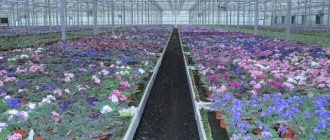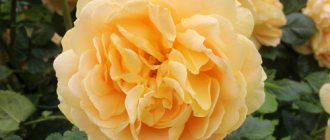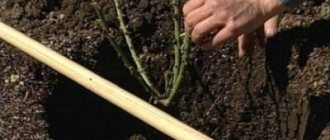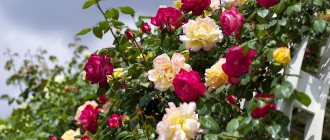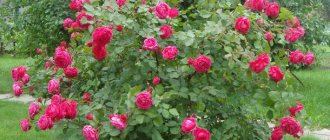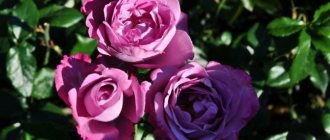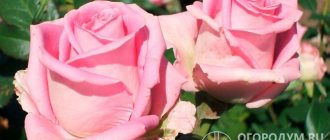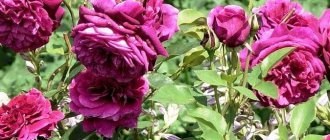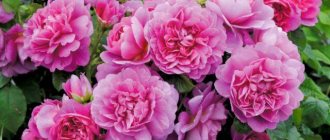If you really sincerely love roses and are the owner of your own flower garden, then it probably contains a couple of climbing varieties of this amazing plant. Or maybe you just have to choose one for your garden? Then be sure to pay attention to the variety with the magical name Ali Baba, which truly seems to have stepped out of the pages of a collection of oriental fairy tales.
Examples of rose varieties from the Climber group
The climbers include the popular lilac rose Indigoletta, famous not only for its unusual color, but also for its surprisingly strong aroma.
This group also includes the famous “rose of the world” New Dawn, which feels quite confident even in zone IV of frost resistance. The popularity of climbers forces breeders to annually develop new varieties of these roses. It is almost impossible to single out the best among them - it all depends on the individual tastes of the grower and the conditions on the site
We can only recommend paying attention to some promising varieties:
Monitoring reviews from rose growers allows us to highlight the strengths and weaknesses of different varieties of climbers:
“Alibaba’s growth energy is very powerful! Flowering is abundant, the bush independently clears itself of faded flowers. The aroma is strong. My bush is 2 years old and has never been sick. Now it is already 150-160 cm in height, about 1 m in diameter. I have not started shaping yet. Survived the winter well; in the spring I cut off only the tops of the longest shoots by 10-15 cm” (Olga, Moscow).
“Patty Lane was great for hot climates. It sits in the hellish sun all day, and the flowers practically do not fade, only brighten a little. In cool weather, the shade is pinkish-creamy in the center and milky around the edges. The flowers do not become smaller by autumn. Very delicate fruity aroma. The break in flowering is minimal. The bush itself is very healthy, has not suffered from anything. The thrips did a little damage, but without much damage, and the spider mites were spared even in the heat. I try to feed well, so I don’t see any problems with growth. But the vines are very prickly and tough, so you need to keep them in a climbing form until the shoots are ripe. Then all that remains is to cut – you won’t bend it” (Natalia, Crimea).
“Don Juan is handsome! Large, magnificent flowers that do not respond to rain at all. True, in the second season after planting I had to tinker and treat the rust and tear off the leaves. But the bush recovered well, and even continued to bloom, despite the fungus. It always winters well. Yes, styling is not easy, you have to work hard, but this rose is worth it!” (Galina, Moscow region)
“Dukat (aka Lancelot) never ceases to amaze! It blooms first of all roses - at the end of May, blooms in two abundant waves, and in between - in single large clusters in different parts of the bush. This results in almost continuous flowering. The color of the flower is very optimistic, bright, on some flowers I notice a slight pinkish blush. The flowers do not suffer from rain and do not fade in the sun. The bush does not suffer from anything, it winters well under minimal spunbond cover, although the manufacturer declared zone VI, and I have a plot in the Moscow region” (Olga, Zhukovsky).
From the comments of rose growers, you can see that growing climbers is possible in most of central Russia. They feel especially good in the southern regions. The most important thing is to carefully choose varieties.
Differences from other roses
Climbing rose “jasmine”: description of the variety, photos and reviews
All modern roses were bred by crossing old roses. Therefore, in modern roses you can always find features of their ancestors. And in old garden roses one can recognize the characteristics of wild-growing species of roses. After all, they also turned out as a result of arbitrary crossing of wild roses. Unlike ancient roses, modern groups are characterized by greater frost resistance and less susceptibility to disease.
They also differ in the duration of flowering. As a rule, old roses bloom once. True, old tea, Bourbon, and remontant roses bloom again, but the second flowering is significantly inferior in abundance to the first. Modern ones go through several waves of flowering. Some types of hybrid tea roses can bloom until late autumn, even before snow falls.
Ancient roses are inferior to modern roses in the variety of colors. The petals of old roses are beautiful, but are usually painted in soothing pastel colors. The colors of modern roses vary widely - from almost black to white, from single-color to two-color and variegated.
Caring for old roses is more difficult. Almost all varieties of old roses have many prickly thorns, large bushes, and long lashes. In addition, they are afraid of frost. All this requires physical effort and regular, careful care: timely pruning, prevention, construction of winter shelters.
Application in landscape design
Groups of old roses are readily used by landscape design specialists. They are used to construct hedges. With the help of such fences, you can zone a site or isolate yourself from neighbors. White Alba roses look beautiful. In the case of single-row planting, the bushes are planted at a distance of 70 cm from each other. In the case of a two-row, the distance between the roses is left the same (70 cm), and between the rows - 100 cm.
Climbing varieties of ancient roses are used for vertical gardening. They decorate arches, pergolas, gazebos, and obelisks. Columns or obelisks covered with roses will create a solemn atmosphere in the park area of your site.
Antique roses also look very beautiful in solitaire (single) plantings. Rose is a self-sufficient plant. It is beautiful in itself, so it can become the main focal point in your garden.
This is especially important when the area of your site is very limited. For single plantings, bush types of old roses are chosen
These roses are not suitable for mobile, container plantings. But they look good in combined flower beds - mixborders. As companion plants, choose those that have a color contrasting with the color of your rose.
Varieties
Climbing rose kimono (kimono): description and photo, reviews
Let's look at the most popular varieties of remontant roses.
- Georg Arends. The bud looks like a pointed cone. The flower is large, pink in color with a satin sheen and a tart aroma. The plant blooms at the end of May, the next flowering occurs in mid-summer.
- George Dickson. Double flowers are painted in rich crimson colors with a transition to red. The bush is quite tall and belongs to the group of essential oil plants. Flowers are used in the perfume and cosmetics industry.
- E. G. Werkmeyster. The flowers, like most remontant varieties, are large and double. Painted in bright yellow warm colors. The foliage is dark green with a shiny surface. Secondary flowering is weak, primary flowering occurs at the beginning of the summer season.
- Paul Neuron. The flowers resemble a bowl in appearance, large, double, deep red, located at the end of long, slightly drooping shoots. The aroma is persistent. The plant can reach 200 cm in height. Subsequent flowering occurs in the summer months.
- Prinz Max zu Schaumburg. The flowers are painted in soft salmon and coral tones. The aroma is rich and persistent. Flowering period is spring and summer.
- Ulrich Brunner Films. Cup-shaped flowers in red-carmine tones, with a persistent aroma. Flowering occurs in spring and continues in summer, but not so abundantly.
- Frau Karl Druschki. The flowers are cup-shaped, white in color, some petals are colored pinkish. It belongs to plants that can bloom until autumn, retaining buds and blooming flowers until the onset of cold weather.
- Hugh Dickson. A bush with the largest crimson flowers, turning into scarlet. Flowering occurs at the beginning of the summer season, with secondary flowering occurring in July.
- "Ferdinand Pichard". The plant is distinguished by the unique colors of its buds. The petals are painted in shades of crimson with vertical light stripes or spots. Each stem forms up to 5 ovaries. The aroma is strong. The bush is most resistant to various diseases, but not resistant to precipitation. The maximum height of the plant reaches 200 cm.
- Baron Girod de L'Ain. The flowers are double, purple, red with a light edging. The aroma is persistent and fragrant. From 3 to 5 flower buds are formed on the shoots. "Baron Giraud de l'Hain" reaches 150 cm in height and has average resistance to rainfall and disease.
Care
Climbing rose climbing iceberg: planting and care
Proper care is very important for the development of the plant. Providing favorable conditions is the key to full growth. By following some simple care rules, you can achieve success even in growing the most capricious varieties of roses.
Watering
In the first two years after planting, it is necessary to provide the plant with regular and abundant watering. Older bushes require more sparse, but plentiful.
Timely watering is very important
Water for irrigation must be settled and not cold. Using water from a hose is detrimental to the root system of roses.
Over-watering should be avoided. It can cause root rot. It is better to water plants older than 2 years only when the soil dries out.
Feeding
For remontant varieties of roses, regular feeding is very important. For this purpose, mineral and organic fertilizers are used.
Roses are responsive to foliar feeding
Nutrition occurs due to mineral supplements, and organic matter, decomposing, helps their absorption.
Basic feeding is carried out in three stages.
In the spring, after removing the cover, complex mineral fertilizer is applied. It will promote the formation of shoots and the formation of buds. In summer, during the period of active flowering, you can apply both mineral fertilizers and organic matter. Under no circumstances should fresh manure be introduced. When using organics, you must strictly observe the proportions when preparing the solution. After flowering, apply mineral fertilizers
You should pay attention that they do not contain nitrogen. It can provoke unwanted growth of shoots before sheltering for the winter.
For your information! Foliar feeding is effective. With this application of fertilizers, nutrients quickly flow directly to the plant. They are carried out before budding and after pruning, as well as under particularly unfavorable weather conditions.
Pruning and replanting
Pruning for climbing roses is the key to successful growth and flowering. It is carried out in three stages - spring, summer and autumn.
Pruning is an important part of care
- Spring. Its purpose is to remove shoots damaged after wintering. Those that are necessary for proper formation are also removed. It is needed to force the shoots to curl in a given direction.
- Summer involves removing faded inflorescences.
- Autumn pruning involves removing dried and diseased shoots. For climbing roses, only the shoots of the current year and some of the two-year-old ones are left. Before sheltering for the winter, the length of the shoots is shortened by half the length.
Important! Pruning should be done with a well-sharpened garden tool. It must be disinfected before the procedure.
Transfer
Under certain conditions, it may be necessary to transplant to another place. For young plants this will not be a problem, but replanting older ones will be very problematic.
Before transplanting, the shoots are removed from the support and shortened by 2/3 of their length. Next, the root system with a large lump of earth is removed.
The transplantation procedure is identical to that used when planting young seedlings. The timing of these two manipulations also coincides.
Wintering
The climbing rose Ali Baba is not particularly frost-resistant and requires shelter for the winter. If this is neglected, the plant may not only suffer, but also die.
Before laying under cover, the shoots are shortened. It is recommended to treat the lashes with Bordeaux mixture to prevent the development of fungus under cover. After this, the lashes are removed from the support and pinned to the ground.
Important! The shoots should be laid on a previously prepared area. A layer of sand is poured onto the installation site and spruce branches are laid out.
For shelter it is better to use an air-dry method. It consists of installing a frame and then attaching covering material to it. This method will ensure free air circulation during the plant's dormant period.
Growing and planting in open ground
Rosa Minerva - growing floribunda
The first step to becoming the proud owner of an Ali Baba rose is the purchase of seedlings.
It is better to purchase seedlings in pots
When choosing planting material, you should pay attention to several important points.
- It is better to make a purchase at a nursery or specialty store. There they are sold in containers or other containers that prevent the roots from drying out and facilitate transportation. Also, the possibility of an error with the variety is practically eliminated.
- Rose seedlings can be either grafted or grown on their own roots. For almost all varietal roses, the choice of grafted seedlings is a priority. They have a more developed root system and increased resistance to diseases and adverse weather conditions.
- The most suitable seedlings for planting are 2-3 years old. By this time, they already have a developed root system and a high rooting ability.
- It is worth paying attention to the leaves and stems. They should be healthy and evenly colored. The presence of stains and any damage is unacceptable.
Important! The correct choice of planting material is the key to success. Only from a healthy seedling can you grow a full-fledged plant that will delight you with flowering and active growth.
Boarding time and seat selection
Before you begin planting, you need to decide when it will take place. Particular attention should be paid to the choice of location.
Planting dates depend on the climatic conditions of the region. For central Russia and other regions with a temperate climate, planting is permissible in both spring and autumn.
The optimal time for spring planting is from April 15 to May 20. The disadvantage of planting at this time is the fact that the seedling quickly begins to build up vegetative mass to the detriment of the development of the root system.
Important! It is preferable to plant seedlings grown on their own roots in the spring. Their root system is weaker than that of grafted ones. When planted in the fall, it may not have time to get stronger before the onset of cold weather.
A feature of autumn planting is the need to cover the seedlings for the winter. The advantage of carrying out the procedure is the opportunity to get a well-developed bush the next year. Rose seedlings planted in the fall bloom the very next year after planting.
When choosing a site for planting, you should avoid places with the following characteristics:
- exposed to constant exposure to strong winds and drafts;
- flooded with melt water and places close to groundwater;
- illuminated throughout the day;
- located under trees and in close proximity to buildings.
All these factors will negatively affect the growth of the rose.
Excessive moisture is detrimental to the root system. It will lead to root rot and the development of fungal diseases. Strong winds can damage tall shoots, as well as dry out the soil and deprive the plant of necessary moisture. Bright afternoon sun negatively affects flowering and can cause burns to shoots and leaves.
The landing site should be sufficiently breathable. Planting too close to buildings will prevent free air circulation. Planting under trees will not only deprive the plant of adequate sunlight, but will compete for nutrients in the soil.
Soil preparation
The survival rate of a seedling and its further development directly depend on the composition of the soil. The Alibaba variety is a remontant rose that is demanding on the composition of the soil. This should be taken into account when planting.
The soil must include compost or rotted manure, as well as peat. It is also necessary to add a dose of mineral fertilizers; superphosphate is perfect. If the soil is clayey, you need to add sand; if it is sandy, you need to add clay soil.
It is better to prepare the soil on the site for spring planting in the fall, and for autumn planting - a month before planting.
Note! It is not recommended to plant young seedlings in places where roses were previously planted. The soil in such areas is already depleted, and there is a high probability of disease infection.
Seedling preparation
Before planting, seedlings are carefully inspected and all damaged shoots are removed. Also lightly trim the roots, removing dried ones.
After removing from the container, it is recommended to place the root system in water. You can add a drug to it to accelerate growth.
To prevent moisture loss and provide the roots with nutrition, in the first days after planting, the root system is dipped in a clay mash. To prepare it, you need to mix ½ part clay and 1 part manure, adding water, until it becomes liquid sour cream.
Before planting, the roots must be wrapped in burlap. This will keep it from drying out and protect it from sun exposure.
Landing
Planting of young rose seedlings should be carried out strictly following a certain sequence of actions.
Landing is carried out sequentially
- First of all, you need to dig a hole. Its size should be twice the size of the root system.
- To ensure drainage, a layer of gravel or broken brick should be poured onto the bottom.
- Prepared soil is poured into the planting hole in a mound.
- The seedling is placed in the center, and the roots are carefully spread over the surface of the tubercle.
- Fill the hole with the rest of the soil and lightly compact the surface.
- The seedling is watered abundantly. One plant needs 1.5-2 buckets of water.
- The soil surface around the planting is mulched with peat, bark or sawdust.
Important! When placed in a planting hole, the grafting site should be deepened by 2-3 cm.
The soil must be compacted after planting.
Before planting, a support must be installed. It should be at least 20 cm from the planting hole.
Only if planting technology is followed will it be possible to grow a healthy plant that will delight you with abundant annual flowering.
Description of rose Ali Baba
Grown in England by C. Warner, one of the country's leading rose growers, this stunning variety features large orange-pink flowers with a captivating fruity scent.
How the Ali Baba rose blooms
The variety belongs to climbing roses with repeated flowering. The height of the shoots can reach 3 m. Large flowers are collected in inflorescences of 5 to 10 pieces. on each.
For your information! It has won many awards for its fantastic blooms and ability to grow to large sizes. The flowers have a truly unique color with shades of salmon and peach. Their aroma is strong and fruity with notes of peach and passion fruit. The flowering is long-lasting, throughout the summer months this beauty pleases the eye.
Advantages and disadvantages
Like every variety, Alibaba rose has both pros and cons.
This variety has quite a lot of advantages
Each one is worth paying attention to when choosing it for the site.
Undoubtedly, the main advantage of this species is the flowers. Besides the fact that they look simply stunning, this beauty will bloom all summer long.
It is also worth noting that, despite the intolerance of many types of roses to an abundance of precipitation, this variety is very resistant to it. Even if rainy weather occurs during the flowering period, the plant does not lose its beauty.
High resistance to disease is another advantage of this variety. This rose is very rarely affected by powdery mildew and various spots.
For a climbing rose with an impressive length of shoots, their flexibility is an undeniable plus. Thanks to this quality, roses can be used to decorate various objects, regardless of the complexity of their shape. The risk of damaging the shoots is minimal.
This variety has fewer disadvantages than advantages. It is thanks to this that she became a favorite of rose growers and received so many awards.
One of the disadvantages is intolerance to direct sunlight. The plant should be illuminated only in the first half of the day; afternoon bright sunlight is harmful to it. In bright light throughout the day, the color of the flowers fades and they fall off faster. Leaf scorching is also possible.
Note! The requirement for soil composition is a dubious drawback, but it cannot be considered an advantage. Rose Alibaba prefers nutritious and light soil
Poor and heavy soils are absolutely unsuitable for its cultivation.
Use in landscape design
Thanks to its exquisite flower color, flexibility and impressive length of shoots, the Alibaba variety is often used by landscape designers.
Powerful vines covered with large salmon-colored inflorescences will decorate any landscape composition. Arches, gazebos, and walls of houses entwined with this climbing beauty will become the highlight of the site.
In combination with roses of lower growing varieties, you can create a continuously blooming bright composition. An additional advantage will be the aroma, the fragrance of which will not leave anyone indifferent.
For creating a flower garden in the English style, this variety is just a godsend. It is this rose that can become the main accent in such a composition.
Use Cases
Using the Ali Baba variety, you can successfully decorate anything: wooden fences, forged fences, building walls. Using various types of supports and resorting to the services of a climbing beauty with fragrant flowers in warm colors, it is easy to design a hedge, arch, or pergola. A garden gazebo covered with roses of this variety will turn out to be very romantic and even luxurious. If desired, low-growing flowering crops with buds in white, red, and pink shades are planted next to the decorative perennial Alibaba.
Rose blossom
Inflorescences are formed on biennial and older shoots.
The most magnificent flowering is observed during the second wave, when lateral shoots appear on the basal shoots, which also bloom.
The rest period ranges from several days to several weeks, depending on the variety.
Rose Ballerina blooms very magnificently
Care during and after flowering
During the period of budding and flowering, the Ballerina rose, like other varieties, needs potassium. A mixture of 1 cup of wood ash per 1 bucket of water or 30 g of potassium sulfate per bucket of water is added to the soil.
For lush flowering you will also need a solution of 1 tbsp. spoons of calcium nitrate per 10 liters of water.
Important! At the beginning of summer, 80 g of superphosphate is applied under the bush
What to do if it doesn’t bloom, possible reasons
A rose does not bloom if there is a lack of sunlight, watering and fertilizing. Flowering can most often be achieved by changing the care conditions.
Reproduction
The most acceptable method of propagating climbing varietal roses is cuttings. The use of this method guarantees the production of seedlings that will be completely identical to the mother plant.
Propagation by seeds does not, in most cases, allow obtaining roses with the required varietal qualities. Obtaining new specimens by rooting cuttings is possible, but the result is quite a small amount of planting material.
The best time to start preparing planting material is in the fall. After shortening the vines before placing them under cover, many trimmed shoots remain. They can be used for subsequent preparation of cuttings.
The method of propagation by cuttings consists of several stages.
- Shoots pruned in autumn, after removing their leaves, are stored in damp peat or sand at a temperature of 1-2 °C until spring.
- In the spring, cuttings 10-15 cm long are cut from the shoots. The lower cut is made oblique under the bud, and the upper cut is straight above it. The lower part is treated with a solution of a growth stimulator.
- In April - May you can start planting in the soil. Depending on climatic conditions, it is produced either in a container or in open ground. Planting is carried out so that there is only one upper bud above the soil level.
- After planting, a film cover is installed to create a microclimate in the greenhouse.
- As the soil dries, watering is carried out.
Some cuttings will take root by mid-summer.
The cutting method allows you to obtain high-quality planting material, while all varietal characteristics are preserved.
Diseases and pests
The Alibaba rose variety is resistant to such common diseases as powdery mildew and various types of spotting. With proper care, the plant practically does not get sick. But if infection occurs, you should immediately treat it with special preparations.
The most common pests of roses are aphids, spider mites, caterpillars and thrips. To combat them, as well as for prevention, roses should be regularly sprayed with chemicals.
Note! Among the variety of climbing roses, the Alibaba variety undoubtedly deserves attention. Tall powerful shoots crowned with large fragrant salmon-colored inflorescences cannot leave anyone indifferent
Agricultural technology and reproduction do not require special skills and effort. If you follow all the rules of care, it is quite possible to grow a healthy and lushly flowering plant. This variety is widely used in landscape design. This is due to the high decorative qualities of the Alibaba rose variety. By planting this beauty in the garden, you can enjoy the beautiful flowers and their unique sweet aroma all summer long.
Description and advantages of the variety
Breeder Christopher H. Warner England, in 2007 presented the world with his masterpiece Alibaba.
The buds have a very interesting, complex color. From coral to pink-orange, from copper to honey. The buds are regular, goblet-shaped at the beginning of dissolution, large. In full bloom, these are densely double flowers, collected in bouquets. The aroma is fragrant with fruity notes of passion fruit and apricot. The rose is a remontant rose - it blooms almost continuously until frost.
High resistance to powdery mildew and spotting. The buds do not droop in the rain. Frost resistance is average, recommended growing zone is 6.
Flexible long shoots reach 200-250 cm. The size of the bush is 250 by 120 cm.
World recognition and awards
- "Gold Standard" tests of the UK National Institute of Agricultural Botany NIAB and the British Rose Breeders Association, 2007,
- first prize at the Lyon rose competition (France), 2008 for fragrance,
- "Best Climbing Rose" competition La Tacita (Italy), 2011,
- bronze certificate of the rose competition The Hague (Netherlands), 2014,
- bronze medal of the Gifu Rose Competition (Japan), 2014.
If you're looking for a climbing rose for your garden, Ali Baba is worth a look.
Very large double flowers
Strong fruity aroma
Disease resistance
Alibaba (Alibaba)
Characteristics of the variety:
Classification group climbing, climber
Flower description: The color changes from salmon in young flowers to pink in re-blooming. The average diameter is 10 -12 cm. There is a bright, rich aroma of passion fruit and apricot. The flowers are double, delicate, scalloped.
Flowering pattern: Medium inflorescences of 3-5 flowers. Flowering is abundant and continuous.
Habit: The bush is large, harmonious, spreading, prickly. Easy to install for winter. The shoots are flexible. Height from 200 to 250 cm, width from 100 cm to 110 cm. The foliage is bright, shiny, green.
Frost resistance: high
Disease resistance: high
Light requirement: partial shade
Special Notes: Self-cleaning grade
Reviews from experienced rose growers:
In the second year of flowering, it shot out a strong shoot about 1.5 m with twenty-nine buds. And this is right after the first flowering on the side shoots of overwintered branches! Wonderful aroma, delicate ruffled flower, self-cleaning and excellent health - a favorite! The rose blooms almost without interruption; when putting it away for the winter, I cut off the buds and flowers. (Olga Ivanova, St. Petersburg)
An ideal rose in all respects, it smells oh-so-delicate, doesn’t get sick, fits, doesn’t fade and cleans itself, on my bush there are always 20-30-40 flowers, so it’s not clear how long a flower lasts, in her case it doesn’t matter. Beautiful, and the bush is beautiful against the backdrop of bright foliage, I would buy a second and a third... (Natalia Evgenievna Petrova, Moscow)
Very full, corrugated flowers up to 12 cm, with a carved edge, in iridescence of complex colors: pink, apricot, ocher, copper in the depths of the flower
A beautiful bush that doesn’t fall or fall apart! The strongest aroma, very generous in flowering. Absolutely resistant to diseases and weather troubles: it can easily withstand rain, does not fade in the sun, and is self-cleaning. And in the first year the flowers fell off very quickly. (Kotenko Svetlana Aleksandrovna, Kharkov)
Very full, corrugated flowers up to 12 cm, with a carved edge, in complex colors: pink, apricot, ocher, copper in the depths of the flower. A beautiful bush that doesn’t fall or fall apart! The strongest aroma, very generous in flowering. Absolutely resistant to diseases and weather troubles: it can easily withstand rain, does not fade in the sun, and is self-cleaning. And in the first year the flowers fell off very quickly. (Kotenko Svetlana Aleksandrovna, Kharkov)
Characteristics of the variety
The Alibaba variety was officially registered in 2007 under the Alibaba rose brand (CHEwalibaba, Schloss Bad Homburg, Sunset Glow, Ali Baba). The selection work was highly appreciated by professionals:
- 2007 (Gold Standard Rose Trials) the variety was awarded the Gold Standard award at variety trials in England.
- 2008 Winner at an exhibition in Lyon (France) for fragrance.
- 2011 Championship in the Climbing Roses category at an exhibition-competition in Italy.
- 2014 bronze award-certificate of the competition in The Hague (Netherlands); bronze medal at the rose competition in Japan.
Alibaba rose climber
Roses from the British breeder Christopher Warner, the originator of this variety, are characterized by resistance to weather vagaries, original colors and high repairability.
Alibaba flowers under optimal conditions grow large (10 – 12 cm), not inferior in size to hybrid tea ones. The flower is semi-double, airy due to the wavy edge of the petals. The color is complex, changing throughout the life of the flower and becomes lighter. The illusion of glow is created thanks to the bright coloring at the base of the petals.
A plant with high growth energy, in the first year after planting it increases its green mass and at the same time produces bunches of buds. Flowering occurs mainly at the ends of shoots. An adult rose, for abundant flowering along the entire length of the shoot, must be placed on a support (horizontal).
Horizontal management of rose shoots
The advantages of the variety include:
- continuous flowering;
- strong pleasant aroma;
- well-leafed shoots, not bare at the bottom;
- resistance to rain: petals are not damaged by moisture and do not rot;
- self-cleaning: wilted flowers fall off and do not require pruning, do not mummify, reducing the decorative value of the bush;
- high plant resistance to the most common diseases in our latitudes (powdery mildew and black spot).
Don't expect cascades of fragrant clusters in the plant's first year in the garden. In the first 2–3 years after planting, the rose adapts to a new place and gains strength. Flowering may end quickly, and the expected aroma may not be heard.
Important! With good care, a rose is able to reveal its potential no earlier than 3–4 years of life in a permanent place
History of creation
The unusual Alibaba culture was obtained according to some data - in 2006, according to others - in 2007 by breeder Christopher Warner. The place of origin of the variety is Great Britain. It has other names, but they are used less frequently than the main one: Schloss Bad Homburg, CHEwalibaba, Sunset Glow. Over the short history of its existence, our heroine has received many awards. First of all, this is the “Gold Standard” title, awarded to the variety almost immediately after its appearance by two organizations simultaneously: the British Rose Breeders Association and NIAB. A year later, the culture won the first prize of the competition in Lyon (France). There, a corresponding award was given to the magnificent aroma of the flowers of this noble plant. In Italy, at the 2011 La Tachita competition, our heroine was awarded the title “Best Climbing Rose” and again given the first prize. In 2014, the Ali Baba variety became the bronze winner of the competition in The Hague (Holland). In the same year, it was noticed in Japan, at the Gifu flower competition, where the plant also received a bronze medal.
What are remontant roses?
Their main characteristic is clear from their name. They all bloom repeatedly within one season. At one time, they became a real breakthrough in the world of rose growing, because previously not a single variety had re-bloomed. However, they are now significantly inferior to newer species such as hybrid teas and floribundas.
And the whole point is that, although remontant roses bloom twice during the summer, the second bloom is much more sparse than the first. More modern species and varieties do not have this drawback, and are able to bloom not only repeatedly, but even continuously throughout the season. At the same time, the quality of the flowers remains high.
The second disadvantage is their susceptibility to disease. They are not as resistant to fungi as later species and varieties.
A reasonable question arises: why are they still grown in gardens if they have so many shortcomings? The thing is that among remontant roses there are varieties whose flowers even today meet the highest standards in floriculture. The effort is worth it to see the beautiful flowers in all their glory, striking in their beauty. And although this spectacle will not last so long, lovers are ready to surround the renovated species with care in order to decorate their garden with them.
In general, caring for and planting remontant roses requires compliance with all the same rules as for other species. It’s just worth paying a little more attention to preventative treatments and regular inspections of the bushes.
They require mandatory pruning to ensure re-blooming more luxuriantly. It is also necessary to apply nitrogen fertilizers throughout the season to promote green growth and abundant flowering.
A large bush, it keeps the tree trunk circle in the shade, which allows watering to be done very rarely, only in the driest weather.
The height of the remontant rose bush reaches 1.5 meters. Of course, it cannot be called compact, which is often also considered as a disadvantage. However, in some gardens tall bushes are in great demand. They are completely self-sufficient and can decorate the site on their own. Not all gardeners like to create groups, and for them a large rose bush is a real find.
Speaking about wintering, it is necessary to note the poor resistance to frost. You need to carefully take care of the shelter in preparation for wintering.
